|
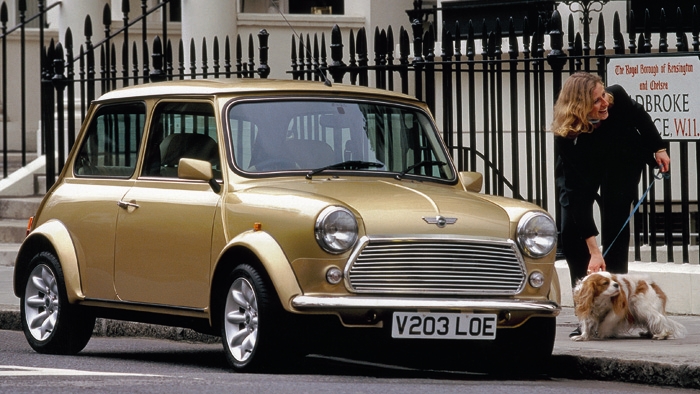
Mini Classic "Final Edition": Mini Knightsbridge
6. From the Original to the Original. MINI Design and Concept Cars.
Innovative, unmistakable, stylish and inspiring time and again.
Just like the classic Mini, the MINI stands for unique design providing brand-new answers to the challenges of
its time. Creating the classic Mini, constructor Alec Issigonis and his team had succeeded in re-defining the entire philosophy of the small and compact car in 1959. Developing the MINI, his successors, as it were,
re-interpreted the concept of maximum interior space on minimum road surface in modern, up-to-date style.
The result, created almost four decades apart, was two cars of supreme character proudly presenting their
unique qualities in a truly unmistakable manner. Both back then and today, thrilling driving characteristics and irresistible design create one complete unit as the sign of distinction of an entire brand.
The starting point for the design of the classic Mini was a vision following clear targets: smaller than all models produced so far by British Motor Corporation, the new car was still to provide sufficient space for four
occupants and their luggage. Clearly, therefore, Issigonis focused on economy of space as the fundamental consideration in the development process.
At the same time he wished to offer an innovative answer to the small and compact cars already available on the market in Europe, following his principle that a good designer should never ever copy the competition.

A clear vision and the right concept: the foundation for the classic Mini.
To provide as much space as possible for the occupants on the car's very small footprint, even the technical
features and components of the classic Mini had to be moved together. The ideal concept making this possible from the start was of course the engine fitted at the front in conjunction with front-wheel drive. But
that alone was not enough for Issigonis. For while there was enough space for a four-cylinder power unit beneath the short bonnet, this was only because Issigonis fitted the engine crosswise and placed the
gearbox beneath the drive unit. Certainly an innovative interpretation of the "form follows function" principle still one of the decisive factors in the design of the MINI to this very day.
Issigonis set forth all these plans and configurations not in long documents and studies, but rather in a host of drawings and personal sketches. Indeed, he had already succeeded in compensating for his rather limited
ambition for mathematics at school and university through his excellent drawings. And now these drawings became the characteristic trademark of this ingenious engineer and constructor.
With just a few strokes of his pencil he was able to create visions, illustrate solutions for complicated technical problems, and therefore develop greater power of conviction than even the most moving speaker in
a detailed technical lecture.
Issigonis' almost contagious euphoria was also expressed by the fact that he often did his drawing on paper table-cloths or menu cards, because his notepad was already full.
One of the legends circulating around the classic Mini is the story of a design sketch done by Issigonis on the paper napkin of a hotel restaurant later used for the first "official" draft on the drawing board in Issigonis'
construction office.
In the course of 1958 both the exterior and the interior of the Mini took on their final shape. Striking features
later to become characteristic of the classic Mini were the body panel seams between the wings and the bodyshell facing to the outside.
The reason for this particular feature was quite simply money: welding seams facing to the outside were a lot cheaper in production.
The second feature typical of cost-oriented production also clearly visible from outside was the door hinges on the outside of the doors themselves. And the driver who was not able to make do with the luggage
compartment offering capacity of 195 litres or 6.8 cubic feet, was able to quite simply leave the bootlid open since the lid was hinged at the bottom, it served conveniently as a "tray" even taking up bulky objects
fastened more or less safely in position. Indeed, this was not even a secret tip, since high-gloss brochures presented this enlarged loading capacity in colourful pictures.
The interior naturally also followed the car's minimalist philosophy: A simple cable served to open the doors and the usual dashboard in front of the driver and passenger was replaced in the classic Mini by a small shelf.
Right in the middle was the centre instrument, the speedometer and mileage counter as well as the fuel gauge, with two toggle switches for the screen wipers and the lights right below.
Despite numerous detailed changes and modifications, the basic shape of the classic Mini remained unchanged for no less than 41 years. In the course of time this revolutionary small car became a classic in
the history of the automobile, a timeless masterpiece chosen in 1995 by the readers of Autocar, the British car magazine, as the "Car of the Century".
Like its driving behaviour, the typical look of the classic Mini remained a perfect image of the car's character over years and decades, ultimately providing the starting point for the design of the modern MINI.
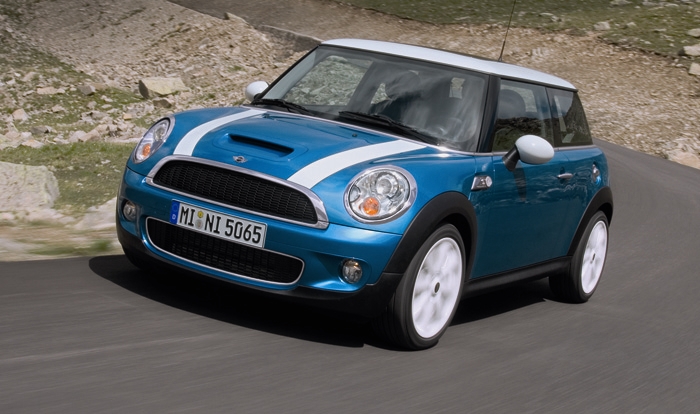
MINI Cooper S - Model Year 2007
Creating the MINI: brand-new, but with unmistakable roots.
Back in the mid-1990s, shortly after BMW had taken over Rover Group, the first plans were considered for a
new version of this unique compact car.
A study of the MINI Cooper was the presented at the 1997 Frankfurt Motor Show, making it quite clear from
now on that this was not going to be merely a copy of the classic model, but rather a modern interpretation of the Mini concept so rich in tradition. Indeed, this concept car combined the classic values of the classic
Mini with the demands made of a modern automobile on the threshold to the 21st century.
A spectacular sports car concept had already been presented at the beginning of the year on the occasion
of the Monte Carlo Rally. Thirty years after the classic Mini had won the Monte Carlo Rally the last time, this two-seater, right-hand-drive mid-engined ACV 30 (Anniversary Concept Vehicle) study definitely hit the
headlines not just on account of its truly powerful and muscular proportions. Rather, the study also made it quite clear how the design features so characteristic of the classic Mini such as the hexagon radiator grille
and the large round headlights could be carried over into a modern vehicle concept.
So the question is obvious: What would the ideal small car look like when carrying forward the ideas and
principles of Sir Alec Issigonis, that ingenious constructor, from the 1950s into the 21st century, with all the technical options and customer preferences of these modern times?
Looking for an answer to this question was certainly a promising undertaking right from the start, particularly as neither the drive concept of the classic Mini nor its virtually unchanged look had lost any of their charm
over a period of approximately four decades.
Precisely this is why the MINI Project Team run originally by Frank Stephenson and later by MINI Chief Design
Gert Volker Hildebrand attached great significance to conveying not only design details, but also the fundamental idea from the early years of the classic Mini to these modern days of motoring.
The MINI was also to be a unique car offering ample space for four with their luggage, featuring an economical drive concept, and boasting driving and handling qualities no other model in this segment was able to offer.
At the same time the development engineers naturally also considered the high standard of comfort now taken for granted as well as the most demanding safety requirements.
The result, obviously, was once again a revolutionary new small car oriented in every respect to the needs of its times and at the same time developed and manufactured according to the quality standards of a leading
premium brand.
Design features and design icons.
This harmony of the targets set by the development engineers and the fundamental values of the concept is
reflected in a unique design authentically visualising the common character shared by the classic Mini and the MINI and borne out by a beautiful play on lines and joints, circles and ellipsoids.
With the car measuring 3.63 metres or 142.9" in length, the overall layout and proportions, including short overhangs front and rear expressing the agile handling of the MINI through its exterior, were all retained as a
faithful rendition of the classic Mini.
The classic subdivision of the car into three sections the actual body, the window graphics surrounding the
entire vehicle as a kind of band, and the roof seeming to hover in space was taken up again in a modern rendition.
The shoulder line extends from the headlights across the muscular shoulders all the way to the C-pillars, where the roof is closer to the body than upfront on the A-pillars. This creates side window graphics opening
up to the front and clearly emphasising the forward-pushing motion and the sportiness of the car.
Features typical of the brand and already unmistakable on the classic Mini were also re-interpreted on the
new model. As an example, a modern rendition of the hexagon radiator grille and the round headlights now no longer surrounded by the wings, but rather integrated in the engine compartment lid, help to give the MINI
its typical face so characteristic of the brand.
The side direction indicator surrounds serving on the MINI to distinguish the individual model variants, are
also acknowledged as genuine icons in design. In particular, the side indicators guide the eyes of the beholder to the joint on the engine compartment lid of the MINI sweeping back at an angle like the joint on
the side panels of the classic Mini.
The rear light clusters standing upright also serve once again as a powerful sign of distinction now featuring
a sophisticated chrome frame on the MINI. Indeed, this is once again a clear reminiscence to the classic Mini which always boasted its chrome look, consistently rejecting the inundation of plastic in automobile design of
the '70 and '80s.
Last but not least, the very concave, three-dimensional and powerful design of the rims again takes up and
reflects the style of the classic Mini, even if the wheels are now larger, wider, and come on runflat tyres.
The interior of the MINI is likewise unmistakable in its design, the Center Speedo in the middle of the
dashboard bringing back a characteristic feature of the classic Mini and enhancing this look to create a truly unique design element.
Up to 1968 the speedometer on the classic Mini was also a central instrument which, through its looks alone, provided decisive inspiration for designing the surrounds on the MINI's control units and switches.
Further, unique highlights come from the round air vents and the elliptic main elements on the door linings reflecting the design language of "circular elements" so typical of the MINI and also to be admired on the exterior.
More than ever before, the current fortes of the MINI come out on the design of the second generation introduced in autumn 2006. Again following the philosophy of "From the Original to the Original", both the
basic design and the unique details of the car were revised and upgraded in the second generation in a painstaking, evolutionary process.
The powerful stance of the car on its big and muscular wheels now emphasises the sporting character of the MINI even more convincingly. The Center Speedo now even larger than before even offers space for the
display of a navigation system, again providing those unmistakable highlights so typical of the brand.
Like the classic Mini, the MINI, thanks to its harmonious and perfectly balanced overall concept, arouses a
feeling of affection and almost love at very first sight. To a large extent this is attributable to the cleverly integrated codes of "human body archetype" design language: Through its proportions and friendly mimicry,
the MINI arouses the protector's instincts. The powerful shoulders of the car, in turn, exude a sense of safety and security, and the body itself excels through its softly flowing shapes.
New opportunities: the MINI Concept.
Through its design philosophy alone, the MINI allows up-to-date, ongoing development of all features so
typical of the brand while retaining its own, unique character. This starting point also provides a wonderful opportunity to carry over the design language so typical of MINI to innovative vehicle concepts extending
the range and wealth of the MINI model family.
The idea to present MINI in a new context was demonstrated for the first time in a fascinating study in 2005,
when the MINI Concept made its world debut at the Frankfurt Motor Show.
Presenting this unique study, MINI paved the way to a brand-new category of cars re-interpreting the
classic shooting brake concept in modern style. The MINI Concept therefore took up traditional design philosophies already borne out in the 1960s in the guise of the Morris Mini-Traveller and the Austin Mini
Countryman, applying these philosophies to modern-day requirements and therefore presenting new options in the body design and functionality of the MINI.
Following the motto "Travel the World", the MINI Concept was presented in a total of four renditions, each highlighting specific facets of the MINI brand and focusing on the place where the cars were being
presented: In Frankfurt the emphasis was on elegance, at the 2005 Tokyo Motor Show the concept model highlighted the British origins of MINI. At the 2006 North American International Auto Show in Detroit the
emphasis was on wintersport, and at the 2006 Geneva Motor Show the MINI Concept paid tribute to the legendary success of the brand in motorsport.
In all cases the concept car boasted a truly innovative door arrangement revolutionising the use of and access to the car's interior: At the rear the designers introduced a Splitdoor configuration based on the
classic door arrangement of the Morris Mini-Traveller and the Austin Mini Countryman. This two-piece rear door with each door element hinged far to the outside and opening outwards offered particularly generous
access to the luggage compartment of the MINI Concept a principle shortly thereafter presented for the first time in a production version of the MINI.
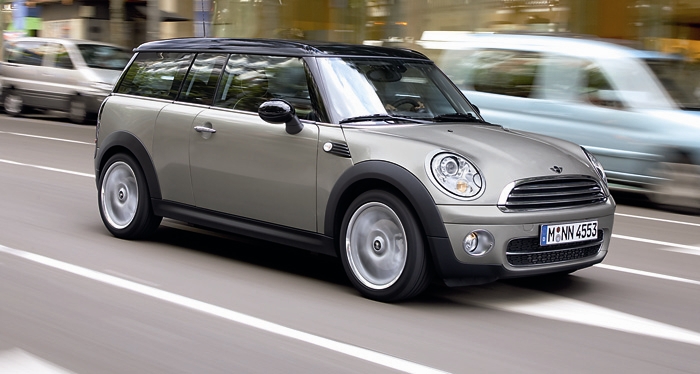
MINI Cooper D Clubman (2007)

MINI Cooper S Clubman (2007)
The MINI family grows: introduction of the MINI Clubman.
The 2007 Frankfurt Motor Show marked the world debut of the MINI Clubman which has been enriching the
model family ever since. Compared directly with the MINI, the MINI Clubman offers 24 centimetres or 9.45" more body length and 8 centimetres or 3.15" longer wheelbase serving entirely to enhance legroom at the rear.
On the MINI Clubman the driver's and front passenger's doors are supplemented not just by the Splitdoor at the rear, but also by an additional opening on the right side of the car. This additional door on the right, the
Clubdoor opening against the direction of travel like a coach door, offers passengers sitting on the rear seats of the MINI Clubman comfortable and convenient access to the rear passenger area.
In its side view the MINI Clubman is characterised by a dynamic wedge shape created through the interplay of the shoulder line rising up slightly to the rear and the horizontal roofline.
Up the A-pillars, the MINI Clubman is identical to the "regular" MINI. It then gains its unique look through its longer wheelbase and longer roofline extending straight back to the steep rear end.
Yet a further special feature is the slight increase in the roof flanks extending on both sides from the A- all the way to the C-pillars along the entire length of the roof and referred to as the Dune Line. This gives the
roofline a truly exciting, eye-catching "sweep" and raises the height of the car's flank by approximately two centimetres. As a result, the proportions of the MINI Clubman are particularly smooth and well-balanced also
from the side.
Like the classic Mini, the MINI is also available with contrasting colours on the roof and indeed, this
particular sign of distinction is of great significance on the MINI Clubman, where, apart from the roof, the C-pillars also come in the contrasting colour ordered by the customer to give the Splitdoor at the rear an
additional optical effect. Ultimately this gives the car a very compact look at the rear and adds to its individual, unique appearance on the road.

MINI Cooper S Convertible Sidewalk (11/2006)
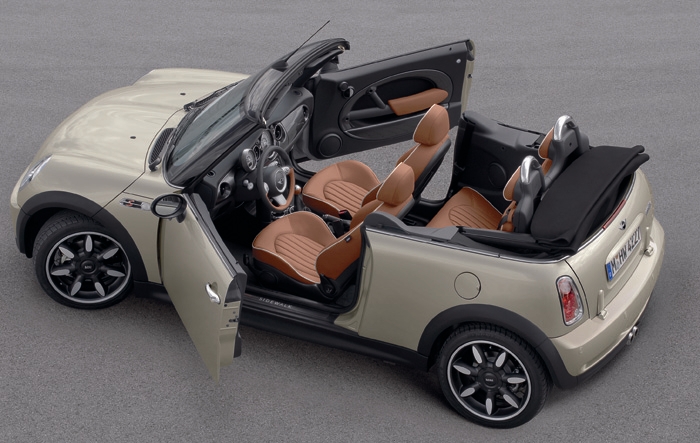
MINI Convertible: consistently open, MINI all the way.
The open-air MINI now conquering the global market in its second generation is likewise a genuine MINI but
at the same time a truly unique character.
While the classic Mini was enhanced by a Convertible model only in the last decade of its unique career, the
designers of the new generation of the MINI fulfilled the loud wishes and requests of open-air aficionados far sooner: The first new MINI Convertible was presented at the 2004 Geneva Motor Show three years after the
closed MINI, but naturally with the same unmistakable design features.
Apart from the soft roof combining the proportions typical of MINI when closed with a unique silhouette, the
four-seater boasted a number of other features typical of a genuine Convertible. The waistline rising towards the end of the car, for example, was accentuated from the start by a chrome bar all round the vehicle, the
steep windscreen was just as characteristic as the chrome-plated rollbar. And at the rear the bootlid opening downwards as well as the hinges at the outside offered further features reminiscent in their design of the
classic Mini.
The new version of the MINI Convertible is experiencing and its drivers and passengers are enjoying its
first summer in the year of brand's 50th anniversary. The front end of this open four-seater once again boasts the face of the current MINI, and the other design features focusing on sporting performance are also
the same as on the closed model.
At the same time the new MINI Convertible is even more mature, more sophisticated and sporting in its look.
With even larger windows, the soft roof offers optimised all-round visibility and the innovative, single-piece rollbar moves up only when required, thus underlining the proportions of the new MINI Convertible so typical
of a new roadster.
Like the side view of the car, the rear end of the new MINI is also even more muscular and powerful in its
look. And in the interest of homogeneous surfaces, the bootlid still pivoting at the bottom as before now comes with hinges at the inside.
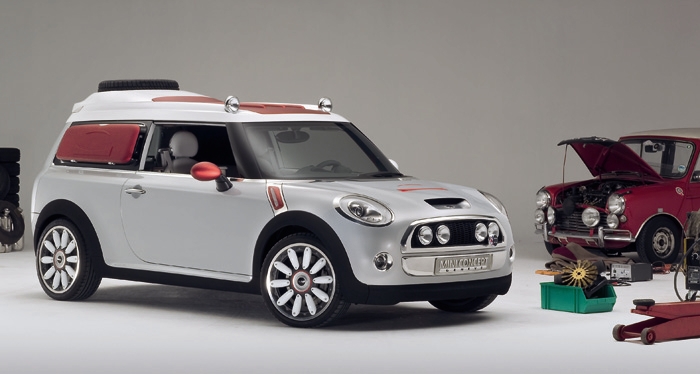
Breakthrough to the fourth dimension: the MINI Crossover Concept.
Even with the MINI, the MINI Clubman and the MINI Convertible, the brand still offers great potential for
further development. Moving into further segments is indeed a very attractive option for the designers, a fascinating example of the wealth of ideas offered by the MINI Design Department being the MINI Crossover
Concept presented for the first time at the 2008 Paris Motor Show.
The MINI Crossover Concept is again a typical representative of the MINI design philosophy and, as a new
model variant without a historical background, takes the brand into a brand-new dimension.
As the first model in the range measuring more than four metres in length, with four drive wheels, four doors
and four single seats, the MINI Crossover Concept offers ample space and freedom of movement at the rear as well as transport capacity never seen before in a MINI.
Further highlights are the car's very flexible interior layout meeting all individual wishes and
requirements.
The MINI Crossover Concept is a truly exceptional four-door, with the conventional arrangement of doors
only on the front passenger's side, while on the driver's side the MINI Crossover Concept comes with the conventional driver's door and a lifting/sliding door providing very convenient access to the rear or for loading
the car from the side.
The single-piece rear door pivoting to one side with its frameless and retractable window serves to offer
additional practical value and easy loading. A further advantage is that the luggage compartment in the MINI Crossover Concept may be enlarged as required by tilting down the rear seats completely into the floor of
the car individually by means of a parallelogram kinematic mechanism.
Yet a further innovative feature on the body is the folding top extending throughout almost the entire length
of the roof and opening from both front and rear, allowing fresh air and warm sunshine into the car according to the driver's and passengers' preferences.
The driver and his passengers enjoy the generous space provided by four single seats with fore-and-aft adjustment also at the rear. Between the seats on the centre console of the MINI Crossover Concept the
highly versatile, multi-functional MINI Center Rail extending from the dashboard all the way to the rear offers not only unconventional storage options, but also a direct connection between the front and rear seats.
This consistent connection throughout the interior is further emphasised by the design of the door linings extending harmoniously from front to rear, visually connecting the two rows of seats.
Yet another highlight within the interior is the innovative three-dimensional central instrument, the MINI Center Globe. This combined control and display unit in the form of a sphere featured for the first time
worldwide in an automobile sets new standards for the integrated control of entertainment, communication, navigation and vehicle functions.
The MINI Crossover Concept carries that unique feeling so characteristic of MINI into a new dimension. It combines the individual style of the brand with spaciousness and transport capacities of a standard never
seen before in a MINI, adding greater flexibility within the interior to meet the most varied requirements of everyday life and leisure-time activities through innovative solutions.
More than ever before, therefore, this new design concept symbolises the MINI's principle of a car transcending all classes and segments of the population and meeting virtually all kinds of mobility
requirements in our modern world.



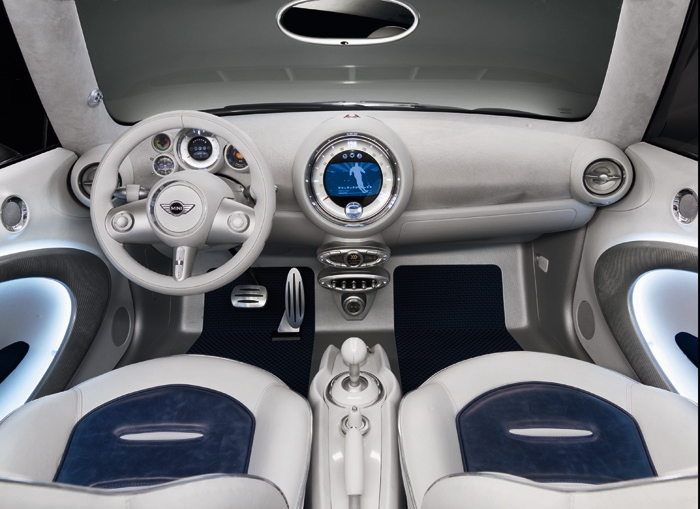
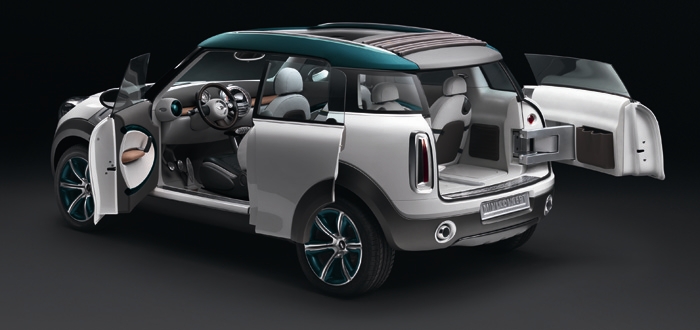
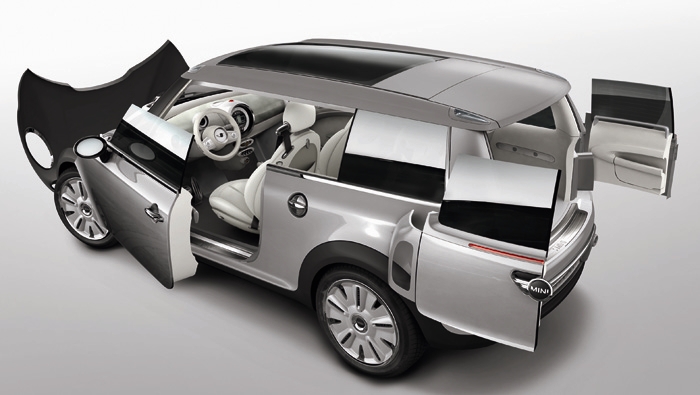
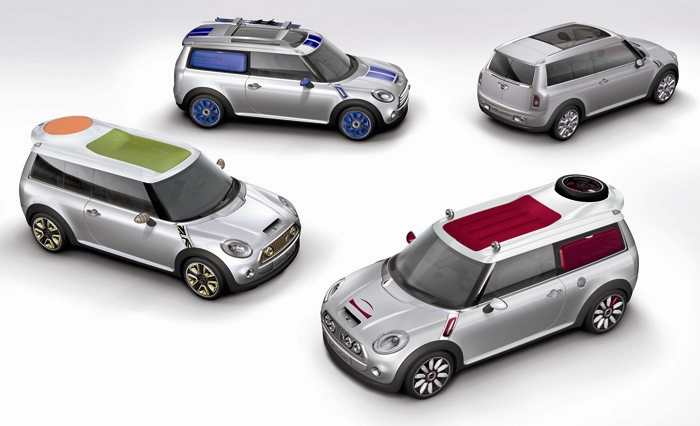
|
